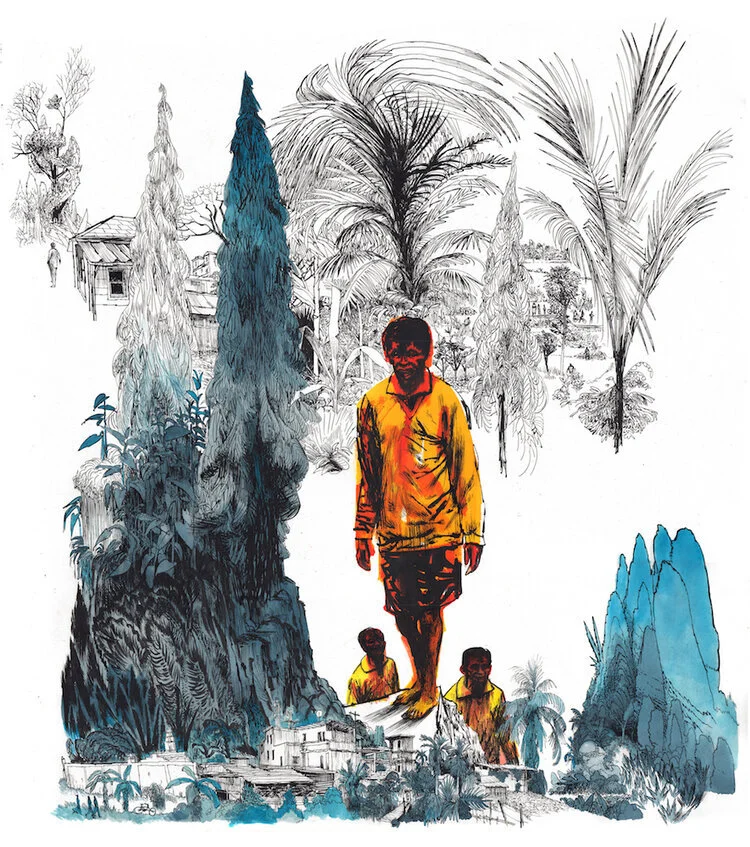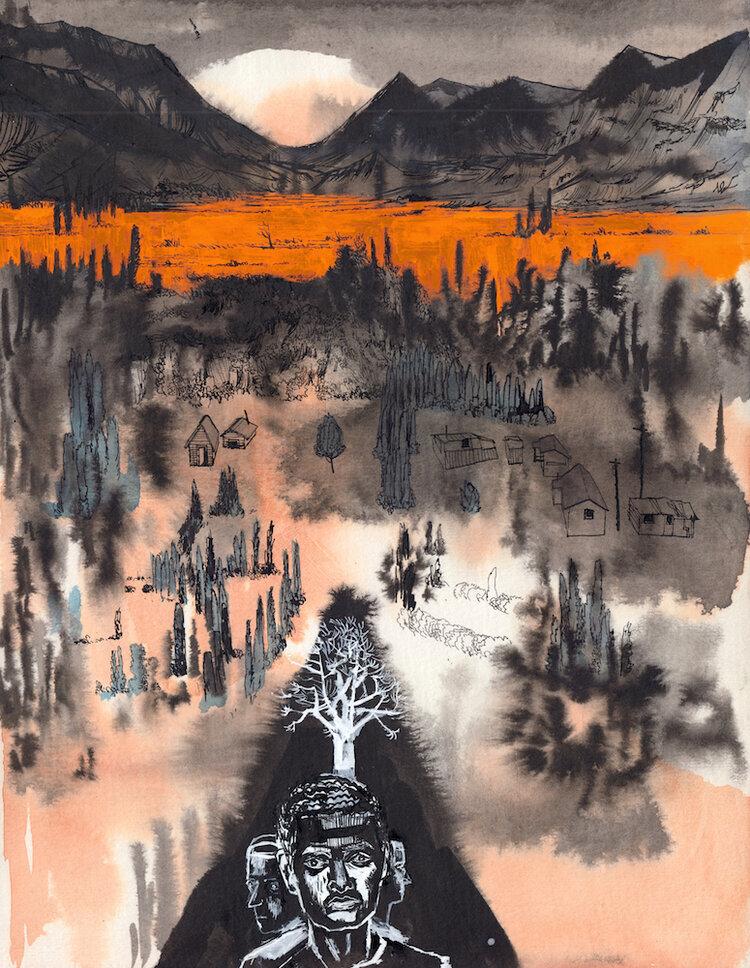Equity Gallery Rebound Series
Matt Rota: Neo Colonialism and the Utopian Ideal
By Matt Rota
Matt Rota, Gardeners of the Estate, 22”x24”, Pen, Ink, 2020
INTRO:
In 2019 Matt Rota was featured in a two-person show, along with Andrew Cornell Robinson, in an exhibition titled Hard-Line. Robinson focused his installation on a recently completed and ambitious collection of prints. Rota showed large-scale pen and ink drawings that referenced the landscape as a political stage tainted with partisan intrigues and man-made disasters that in hindsight demonstrated uncanny prescience. In this latest iteration of the Equity Rebound Series, Rota discusses his latest series of ink and gouache drawings titled “The Estates,” his travels to India, and how his current art relates to the works featured in Hard-Line.
I spent all of January traveling in northern India to research a book project. A month after returning to the states, the Covid-19 health crisis shut everything down. My studio practice and work life is intertwined and comprises teaching at MICA and SVA, freelancing as an illustrator, and working on self-driven personal projects. In response to the pandemic, my classes migrated to online delivery. Luckily my studio is in my home, and was easily transitioned into an online classroom. My freelance work continued unhindered during the pandemic. Unable to travel far from home, or participate in anything resembling a social life, I was able to dedicate whatever time I had left over from my teaching and freelance illustration “day jobs” to create a new body of work. This body of work, titled “The Estates”, was inspired by the India trip and ongoing research on the history of colonial era agricultural expansion and concurrent industrial development on the American continent and in India. Specifically, I became interested in the parallels between the founding of the United States, and the expansion of colonialism within the Indian subcontinent in the 19th century.
Matt Rota, Migration, 11”x14”, Pen, Ink, Gouache, 2020
“The Estates” series expands upon the political and historical ideas, similarly explored through landscape motifs, that I began in the “Hardline” series. I had not set out to focus specifically on the concept of the colonial landscape. The topic of the book project noted above is Indian tea--hence the trip to India. In preparation for the trip I researched the history of tea, and the tea industry in India. Given India’s history I assumed its current tea industry would have been shaped by British colonialism, but had no idea it was an industry that was created by the British, and solely for British consumption. There is no history of tea consumption in India prior to the British conquest there. Having returned to the states, and forced into quarantine after traveling to Darjeeling and Assam, I had the time and space to unpack the experiences I had taken away from the trip. I had taken thousands of photos and kept a daily journal. Re-living the trip through these reference materials, I became more and more focused on the 19th century, both in the economic and political developments in the United States, and in India. Their destinies seemed to me to be flip sides of the same coin— tied together due to their relationship with the British Empire. The developments that we see in that century, such as the acceleration of slavery in the South, the expansion of agriculture into the Louisiana territory, the Rise of the British Raj, and the evolution of racial supremacy in both countries, are major historical events that combined agriculture, labor, race and the evolution of white supremacy. The image of the colonial landscape as an untouched Eden is the idea that land exists to generate fortunes and empires. So the reasons for why it is idealized are the exact same reasons for why it is was destroyed.
Concepts of private ownership both of land and humans, labor, migration, cultivation and exploitation, the ideal and the ruined, are visual themes that run through the series. These are the first pieces in a growing body of work exploring the growth of agriculture and labor during the 19th century. The work draws inspiration from varied sources including 17th century Dutch painter Roelant Savery, the engraver Aegidius Sadeler, the Hudson River school painters, 18th century engraver Robert Benard 17th century French engraver Jacques Callot, and 16th century Swiss printmaker Urs Graf.
Matt Rota, Cliffside Estate, 11”x14”, Pen, Ink, Gouache, 2020
Prior to this series, my landscapes drawings were largely in black and white using pen and ink. I preferred the starkness of the media—it is both neutral and emotionally austere. With this new work I wanted to pull away from that fixed tonality and find ways to add randomness and unpredictable elements to my working process. These drawings start with a wet on wet process. I brush water on the entire page and start sketching in colored ink, and sometimes layer black ink on top of that, such that the initial ink washes bleed and blend together in ways I can’t control. I treat a number of pages that way and sit with them for a while. Next, I draw in the landscape details from a combination of reference photos, onsite sketches and imagination, working in and around the rippled ink spills. A final layer, sometimes using gouache, creates flat bold colorful elements. I use an acrylic gouache, which allows me to work back into the flat color areas and add more detail. Given the intricate layering, these pieces are created slowly and worked on simultaneously. As I experiment with narrative elements or techniques on one, and discover something that works, I can apply these discoveries to other works in the series. This improvisational process allows the images to grow together and organically layer by layer. Though I’m working from a set of references, and focusing on a particular, pre-determined theme to arrive at a coherent series, the improvisation applied to each single piece allows for surprises, and unpredictable, unplanned interactions within a drawing.
Matt Rota, Ghost House, 11”x14”, Pen, Ink, Gouache, 2020
Matt Rota’s new work is available for sale at:
To view a virtual studio visit with Rota click here
For additional information and questions regarding collecting Rota’s work kindly
email michael@nyartistsequity.org




